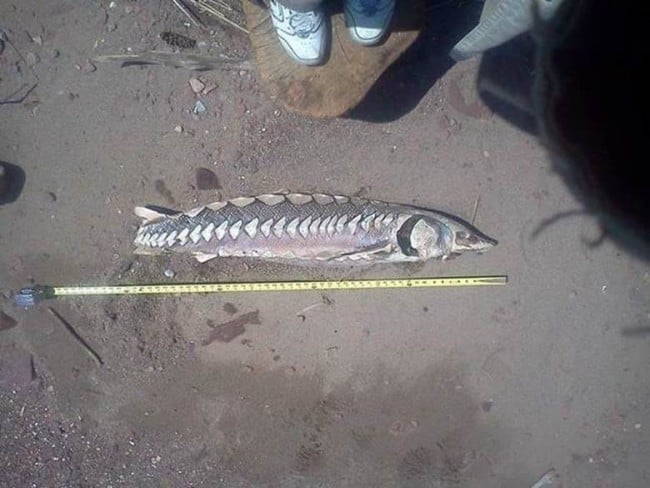Fisheries Service agrees to re-examine Tappan Zee Bridge project as reports of dead sturgeon continue to mount

Sturgeon photographed by Daniel Wolff at beach in Upper Nyack on April 20, 2013 (Photo: Daniel Wolff)
View more images on our Flickr site

Sturgeon photographed by Daniel Wolff at beach in Upper Nyack on April 20, 2013 (Photo: Daniel Wolff)
For Immediate Release
Nov. 17, 2015
Contact: Leah Rae, Staff Writer
914-478-4501, ext. 238, [email protected]
Ossining, N.Y. – The National Marine Fisheries Service is re-examining the impact of the Tappan Zee Bridge replacement project on endangered Hudson River sturgeon, following a petition by Riverkeeper that highlighted an alarming increase in reported sturgeon deaths. Riverkeeper continues to call for federal action to protect the fish.
Records kept by New York State show a continuing surge in the number of sturgeon found dead along the Hudson River Estuary since the massive construction project began. The timing of the mortality increase aligns almost exactly with the start of bridge construction in 2012.
During 2012, when crews began installing test piles for the new bridge, eight sturgeon deaths were reported to the state Department of Environmental Conservation. That was more than in the four prior years combined.
In 2013, when construction began in earnest, 25 sturgeon deaths were reported. In 2014, 43 were reported. And so far in 2015, 46 have been reported.

In the four years prior to construction, six dead sturgeon were reported. In the four years since construction started, 122 were reported. Since the start of construction, reported mortality has increased more than 20 times.
Often, sturgeon were found cut in half, gashed or severed at the head or tail due to vessel strikes. Necropsies on two sturgeon recovered by bridge construction crews close to the construction site in June 2015 (Atlantic sturgeon) and August 2015 (shortnose sturgeon), found that the deaths were likely caused by vessel strikes. A third sturgeon (shortnose) found by construction crews, in May 2014, was deemed possibly killed by a vessel strike.
Pace Environmental Litigation Clinic, representing Riverkeeper, petitioned the National Marine Fisheries Service (NMFS) July 9 to renew its examination of the bridge project and take immediate additional action to protect sturgeon from dangers posed by construction activities. The federal agency, part of the National Oceanic and Atmospheric Administration, is responsible for protecting endangered marine species.
Riverkeeper has learned that the Fisheries Service, as requested, has “reinitiated consultation” with the Federal Highway Administration, the lead agency for the bridge replacement project.
“We are pleased that the Fisheries Service has agreed to review the bridge project in light of the increased sturgeon mortality since 2012. However, ‘reinitiating consultation’ will not, in itself, increase protection for the sturgeon in any way whatsoever,” Riverkeeper Patrol Boat Captain John Lipscomb said. “It remains to be seen whether the Fisheries Service will require the contractor or the Thruway Authority to modify construction activity in order to provide additional protection for sturgeon.”
Before construction started, the Fisheries Service closely studied the project’s potential threat to endangered Atlantic and shortnose sturgeon. In a series of “biological opinions,” it concluded that the bridge replacement project was “likely to adversely affect, but not likely to jeopardize the continued existence” of Atlantic and shortnose sturgeon so long as sturgeon impacts were kept within the confines of an “Incidental Take Statement.” It allowed that dredging and pile driving would likely cause the deaths of two shortnose sturgeon and two Atlantic sturgeon over the anticipated five-year course of the project, and that if “take” remained within these numbers, the project would not likely further jeopardize the two endangered sturgeon species.
This toll was deemed the “incidental take,” permitted by the Fisheries Service and the state Department of Environmental Conservation. While NMFS allows the deaths of two sturgeon from each species, it specifies that none of the mortalities may be adult Atlantic sturgeon, and no mortality should result from vessel strikes.
In weighing the threat from vessel strikes, NMFS assumed that all project vessels would travel at “slow speeds, less than 6 knots” (6.9 miles per hour) in the construction zone. Riverkeeper has observed project vessels routinely traveling at much faster speeds in the zone, including wide areas of shallow water where sturgeon are in close proximity to vessels and their dangerous propellers. NMFS states that “sturgeon may also be better able to avoid slow moving vessels than fast ones.”
The reality is, the DEC records indicate that more than 50 percent of the sturgeon found dead had signs of vessel or propeller strikes.
Riverkeeper seeks enforcement of the speed limit and other protective measures that are best determined by fisheries experts but that could include propeller cages or jet-powered boats to reduce the risk to sturgeon.
By reinitiating consultation, the agency will determine whether increased protections are necessary to protect sturgeon from bridge construction activities, and if so, what those protections should be. According to the Fisheries Service, this process should be completed later this fall.
Riverkeeper Petition to National Marine Fisheries Service
Exhibits: DEC spreadsheets on sturgeon mortality reports, 2007-2014
DEC spreadsheets on sturgeon mortality reports, 2015
DEC spreadsheets on sturgeon mortality reports, September 2015
DEC spreadsheets on sturgeon mortality reports, October 2015
Sturgeon necropsy report, June 2014
Sturgeon necropsy report, November 2014

